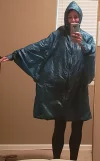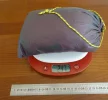- Time of past OR future Camino
- Various routes 2016 - 2024
@C clearly suggested that there might be enough interest for a separate thread on this piece of DIY rain gear.
I first learned about the Parcho here on the forum from @Pong. The designer named it Parcho for Parka/Poncho. It's similar to the popular Altus in that it has a full front zip and long sleeves. However the sleeves are quite different - they are triangle shaped, and roomy, so there is more airflow than a normally shaped sleeve would give you. You can also easily pull your arms out of the sleeves and into the interior of the Parcho to adjust your pack, get something out of your waist pockets, etc.
You make the Parcho to fit your size with your pack. Mine came in at 7.2 ounces.
It can be made from a kit from Quest Outfitters, or you can purchase the pattern separately and buy the components elsewhere. Here's the PDF of the instructions.
I've made two so far, one for myself, and one for a friend. I'm working on a new one with a couple of small modifications and I'm trying out a slightly lighter weight fabric that I bought from RipstopbytheRoll. When I'm finished with it I'll share here how it is compared to my original silpoly Parcho. One of the modifications is something that I changed on my original Parcho after my first two Caminos - I changed the zipper to one that opens from top or bottom. That way I can open it up much more to provide better airflow when it's not raining hard. I'm also going to add a couple of loops with velcro or snaps that my backpack shoulder straps can go through so that I can have it sort of hanging on the back of my backpack on those days that the rain is intermittent I can quickly take it off and on.
The fabric is tricky to sew. I have found that putting a piece of tissue paper or removable fabric stabilizer under it as I'm running it through my sewing machine helps maintain an even stitch.
Here's a couple of pictures of me wearing it over my 36 liter backpack. As you can see, the whole arm, and even hands are covered.
(click on the pictures to enlarge)


I first learned about the Parcho here on the forum from @Pong. The designer named it Parcho for Parka/Poncho. It's similar to the popular Altus in that it has a full front zip and long sleeves. However the sleeves are quite different - they are triangle shaped, and roomy, so there is more airflow than a normally shaped sleeve would give you. You can also easily pull your arms out of the sleeves and into the interior of the Parcho to adjust your pack, get something out of your waist pockets, etc.
You make the Parcho to fit your size with your pack. Mine came in at 7.2 ounces.
It can be made from a kit from Quest Outfitters, or you can purchase the pattern separately and buy the components elsewhere. Here's the PDF of the instructions.
I've made two so far, one for myself, and one for a friend. I'm working on a new one with a couple of small modifications and I'm trying out a slightly lighter weight fabric that I bought from RipstopbytheRoll. When I'm finished with it I'll share here how it is compared to my original silpoly Parcho. One of the modifications is something that I changed on my original Parcho after my first two Caminos - I changed the zipper to one that opens from top or bottom. That way I can open it up much more to provide better airflow when it's not raining hard. I'm also going to add a couple of loops with velcro or snaps that my backpack shoulder straps can go through so that I can have it sort of hanging on the back of my backpack on those days that the rain is intermittent I can quickly take it off and on.
The fabric is tricky to sew. I have found that putting a piece of tissue paper or removable fabric stabilizer under it as I'm running it through my sewing machine helps maintain an even stitch.
Here's a couple of pictures of me wearing it over my 36 liter backpack. As you can see, the whole arm, and even hands are covered.
(click on the pictures to enlarge)
























